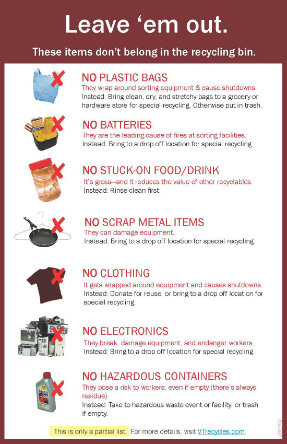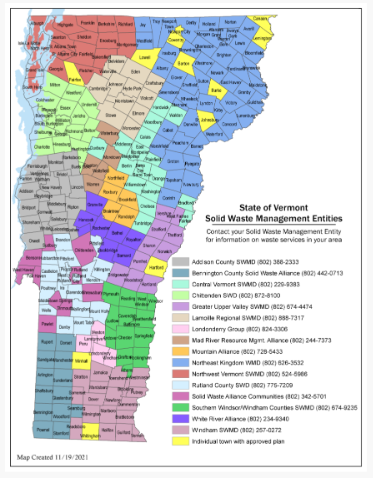Recycle Like You Live Here - Three Easy Steps
Why recycle?
It's a simple way you can take care of our beautiful state. Recycling creates jobs and new products, reduces climate change, and conserves resources, energy, and landfill space. For all these reasons, recycling is required in Vermont as part of Vermont's Universal Recycling Law. Thankfully, you can Recycle Like You Live Here with these three steps.
1. Learn what goes in Vermont's blue bin recycling:
All Vermont recycling programs accept aluminum foil and cans, steel cans, glass bottles and jars, paper, cardboard, and plastics #1 and #2 recyclables. These materials are banned from the landfill by Vermont's Universal Recycling Law. All Vermont residents, businesses, schools, and institutions must recycle:
- Empty and rinsed clean Containers like bottles, cans, and jars. They don't have to be perfectly clean—just free of most residue.
- Paper, Boxboard, and Cardboard should be clean and dry. Remember to break down and fold large cardboard boxes
- Items must be at least 2 inches in 2 dimensions to go into blue bin recycling. Items should be no larger than 2 feet.
The Vermonters' Guide to Recycling poster in العربية (Arabic), Bosnian, မြန်မာစာ (Burmese), دری (Dari), Français (French), <中文(Mandarin Chinese), नेपाली (Nepali), Spanish (Español), and Swahili.
Curious about the journey your materials take after you recycle them? Explore our "What Happens to My Stuff?" webpage.
2. Learn what should not be recycled in your blue bin.
Real people sort your recycling. When you put the wrong things in your bin, it makes their job gross—or downright dangerous. The list below are things that cause the most problems at sorting facilities. Please don't put them in your recycling bin. Some of these materials can be recycled through special recycling drop-off programs!
Do not recycle:
- Styrofoam, drink cartons (milk, juice, pouches, etc.), or black plastic items. There is no current market for these materials so these items are trash.
- Anything smaller than two inches on two sides, or larger than two feet.
- Bagged recycling. Recyclables should also be loose because bags clog up the sorting machines.
- Anything with leftover food on it (ew!)
- Any batteries, scrap metal items, clothing, electronics, or household hazardous wastes. These items have special recycling programs, contact your local solid waste experts at 802recycles.com to learn more about your local options.
3. Contact your local solid waste experts to learn more, and keep on recycling!
Your local solid waste district, alliance, or town can offer more details about your community's recycling program, including information about transfer station hours of operation, and local haulers offering service in the area. Contact your waste district or town to learn more or to explore their A-Z guide.
Visit our "What Do I Do With This...?" page to learn more about state-wide drop-off recycling programs for other materials, like electronics, batteries, and paint.
Have questions?
- Explore our "What Happens to My Stuff?" webpage.
- Call the Waste Management Division switchboard at (802) 828-1138.
- Post questions on the Vermont Recycling & Composting Initiative Facebook page or send a private message.
- Explore our "How Can I Waste Less?" webpage for tips that can reduce your trash and recycling. Some of the tips can save you money!
- Find transfer stations or recycling centers near you using the Materials Management Map.
Help spread the word!
Go to the Universal Recycling Downloads page for posters, fact sheets, and signage for recycling, food scrap, and trash containers.




